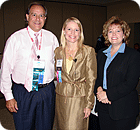
Forecasting has key advantages, according to Bradshaw. "Business forecasting is essential for two reasons," she said. "One, it unites all of the employees of a company for a common goal. And two, variances from the forecast are an early indicator of potential business problems; the owner can make corrections before the problem(s) hurt the company."
Bradshaw talked about studying past key performance indicators (KPI) which include products sold and carried in inventory. She used a Lennox tool called the Healthy Climate Repeat Media Filter Sales to demonstrate how past sales can predict future sales.
Using this tool, HVAC contractors can use the number of yearly equipment installations to project estimated growth percentages, percentages of mix (e.g. MERV 10 or MERV 16 filters), selling price, and annual price increases.
"Using this calculator, dealers can figure what they will have in filter sales five years from now," Bradshaw said. She showed that 500 installations in the first year could lead to $250,000 in filter sales by the fifth year.
Both women discussed several business forecasting methods. Bradshaw said the "rearview mirror" method involved looking at what a business did in the past and to keep doing the same successful things. "If it ain't broke, don't fix it," she said.
Boyce mentioned the "roll forward" method using a projected revenue increase of 15 percent. "Multiply what you did last year by 115 percent," she said. "Do what you did last year and add in a planned 15 percent growth."
Bradshaw talked about the most aggressive method- the theoretical production model.
She added that using the theoretical production model can enable contractors to realize 16-20 percent earnings before income taxes (EBIT).
Boyce noted that contractors can also use a method called "gap analysis" to help with forecasting. "What stands between you and your goal (gap)?" she asked. One of the things that stands between contractors and their goals is the first-time fix rate. If contractors can reduce the number of callbacks by as much as 10 percent, multiplied by the number of techs, the "total revenue improvement is amazing" she said.
So what time limits should contractors place on forecasting- how long should the plan be? Bradshaw and Boyce said that all plans should include well-defined milestones and be broken down into one-year and three-year plans.
Boyce took the idea one step further. "For overachievers, you owe it to yourself and to your family to put together a 25-year plan," she said.
Business forecasting is both an art and a science, according to Bradshaw. "The science is the mathematical formulas and the art is how you interpret these formulas for a particular market," she said.
Boyce said, "Don't leave your fate to chance. Implementing even the simplest of business forecasting tools and techniques can greatly increase your odds of winning."
Publication date: 10/09/2006



